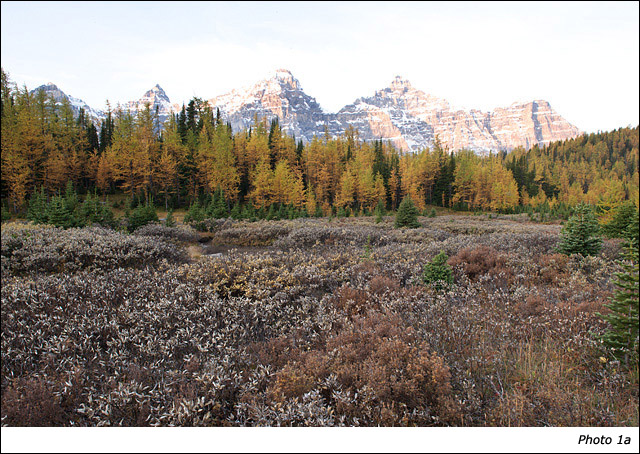
I admit it - I am a filter junkie. I rarely take a landscape photo without a filter attached to my lens! For me, filters are not used for gimmicky effects but are used to overcome the main limitation of digital sensors, which is the lack of ability to record wide ranges of contrast. My two most used filters are the polarizer and neutral density graduated filters (ND grads for short). Both of these filters help reduce the range of contrast in photos so that the sensor can record all the tones in a scene. For example, Photo 1a (above) has no filters used while photo 1b (below) was taken with a warming polarizer (to reduce contrast and saturate colors).
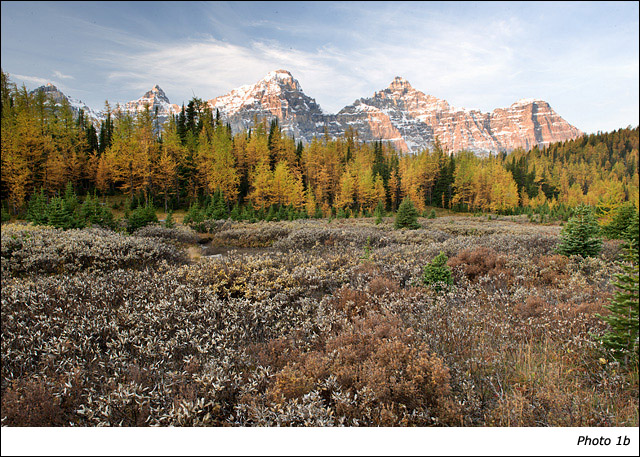
Photo 1c (below) was taken with both a polarizer and a 2-stop hard-edge grad filter (to further reduce contrast between the dark foreground and bright sky and mountains). You can readily see how much more information is gained and recorded on the sensor in the filtered shots and especially in the multiple filtered image below.
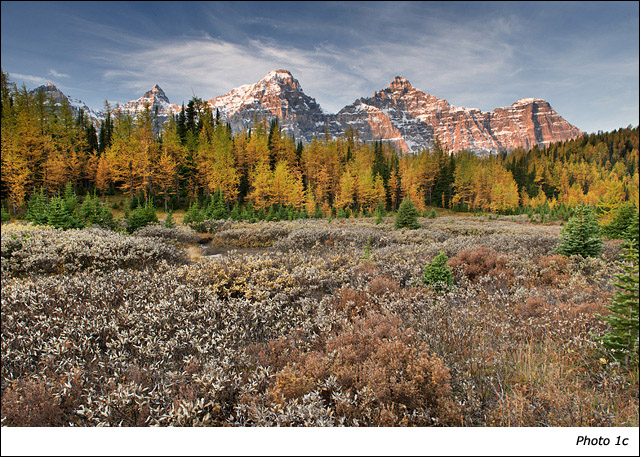
If you do not know how a polarizer and/or a grad works or how these filters can help your landscape photography I recommend the following articles: Fields of Gold (or was that blue?) – three camera filters all digital photographers should be using, Filters for Outdoor Photography and The Art of Filtration in the Digital Age – Part 2 Neutral Density Filters. If you want more information on the power of using multiple filters this link will help you out.
This article does not cover what each filter does or how to use filters but is simply an explanation of how to build a filter system so you can use multiple filters for contrast reduction. The biggest problem photographers have when using multiple filters is figuring how to get filters stacked onto their lenses and how to prevent vignetting caused by filter holders and stacks of filters on the lens. For reference purposes, I use the following four filters often in various combinations: Singh-Ray LB warming polarizer, Singh-Ray Gold-n-Blue Polarizer, Singh-Ray Galen Rowell Graduated Neutral Density Filters, and Singh-Ray George Lepp 5-stop Solid ND filter. Mostly, I use one of the two polarizers combined with an ND grad to hold back brightness in the sky and often combine one of the polarizers with a 5-stop solid neutral density filter for motion effects with wind or to build up colour in sunrise and sunset shots. Usually I have two or three filters on my lens at a time. The question I get most often get is how do I stack multiple filters on my lenses. Here’s how I do it.
The Cokin P-Holder
Rather than use screw-in filters on my lens, I use drop-in filters that slide into the Cokin P-Holder. All of the filters mentioned above are in Cokin P-size and they drop into slots in the filter holder. The Cokin P-Holder has become somewhat of an industry standard for photographers and many companies besides Cokin make filters that drop into this holder. The benefit is that photographers have a wide array of filters available to fit into the Cokin P-Holder. If you are unfamiliar with how the Cokin holder works on lenses, I recommend visiting this link for a clear explanation. Essentially, all you need is an adapter ring that screws onto the front of your lens and then the P-Holder slides onto this ring and the filters drop into the filter holder (see photo 2). If you have adapter rings in sizes that fit the front of all your lenses, you can swap the holder between lenses and use your drop-in filters on any lens. This way, you only need one polarizer (shown in photo 2 below), one set of grads, one solid ND filter for use on any lens.
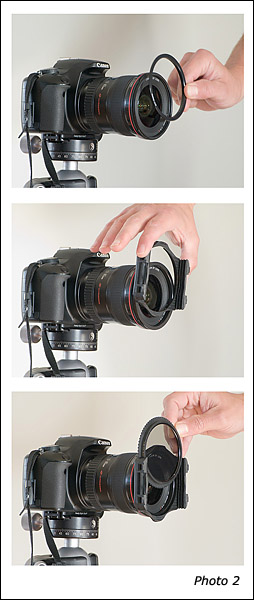
Because I almost always use filters in my landscape photography, having only one filter holder was problematic because I had to switch the holder every time I changed lenses (very frustrating at -30 degrees!). To make my life easier I have a Cokin P-Holder permanently attached to each of my lenses (see Photo 3 below).
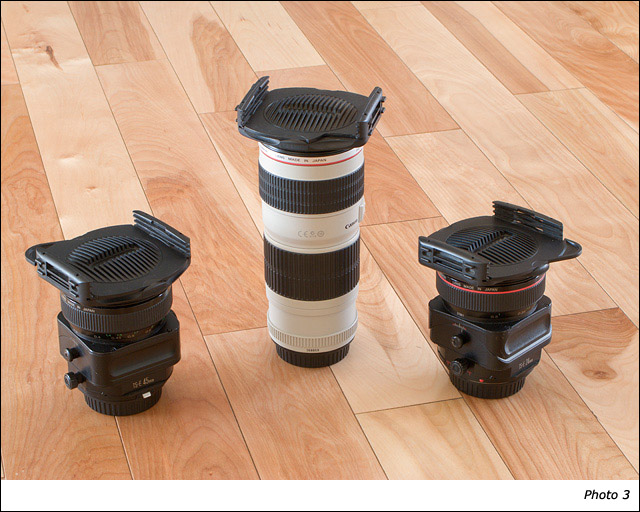
Each holder has a protective lens cap that fits into the holder and it becomes really easy to swap filters between lenses. Just pop off the lens cap and drop whatever filters you need into the holder. Changing lenses? Pull out the filters, put in the lens cap, switch to the other lens, pull out the lens cap on the new lens and drop in the filters – fast and easy. Cokin holders are relatively inexpensive and it is no hardship to have one holder permanently on each lens. I highly recommend this approach!
I do not use UV or skylight filters on my lenses (they provide no visual benefit) and having a Cokin holder attached to the lens actually offers more protection to the lens than a ‘protective’ filter. If you screw a Cokin adapter ring onto a UV or skylight filter and then put the holder on the front of the filter you risk having the edges of the holder show up in your photos especially with wide angle lenses. Do yourself a favor and screw the Cokin adapter ring directly onto your lens and toss out those useless UV and skylight filters!
Vignetting – A Painful Reality?
Speaking of vignetting, wide-angle zooms often have such a wide angle of view that the edges of the photos catch the edge of the holder and every photo has darkened edges. After doing numerous tests, I have found that the Cokin P-holder and/or the drop-in sprocketed P-sized polarizers will cause vignetting on lenses wider than a 24mm fixed focal length lens or wider than 28mm on wide-angle zoom lenses with full frame sensor cameras. For example, I see no vignetting with my 24mm TSE lens but I see serious vignetting at 24mm on my 24-70mm zoom when using a sprocketed polarizer and a P-sized holder. With APS-sized sensors, you can shoot as wide as 17 or 18mm without vignetting, so popular lenses such as a 17-40, 17-55, or 18-200 work well with a Cokin P-Holder on these smaller sensor cameras. If you do not own nor plan to own lenses wider than stated above, you are safe to use a Cokin P-holder without running into vignette issues.
Some people have come up with ingenious ways to overcome the vignetting issue with wide angle lenses and Cokin P-sized filters. Many photographers just use a thin mount screw-in polarizer and then hand-hold the grad in front of the lens (but with greater risks of scratching the grad filter). Others use Cokin P-holders with one or two slots sawed off or use ‘wide-angle’ P-holders that have one main filter slot (but these options limit the use of multiple filters). Other photographers use rubber bands, clamps and other devices to hold their filters over the lens – for example, see NPN photographer Kevin McNeal’s solution here.
None of the lenses I use (the 24, 45, or 90mm TSE lenses, or my 70-200 f4L or 300 f4L lens) vignette with the Cokin P-holder but for many photographers the frustration of vignetted edges really makes the Cokin P-holder an unusable option for them. What is the solution?
Go Big!
The solution for using multiple filters on wide angle zooms such as the 16-35, 17-40, or 24-105mm on a full frame camera or the 10-20 or 12-24mm on an APS-sized sensor is simply to get a bigger filter holder and bigger filters so the holder or filters do not intrude into the angle-of-view of the lens. Cokin makes the Z-Pro holder which holds drop-in 4x6 inch grads (100 x150mm) and also drop-in Z-series polarizers. In my tests, none of the wide angle zooms I use (10-22, 17-40, or 24-70mm) vignetted with the Z-Pro holder. The great thing about the bigger holder is that I can still use drop-in polarizers plus grads plus a solid ND filter to get the same effects I get when using the smaller Cokin P-sized filters and holders. At this time, only Cokin makes a drop-in polarizer for the 4x6 holder in circular (Z-164), linear (Z-160) and blue-yellow (Z-173) configurations. The ‘blue-yellow’ gives similar results as the Singh-Ray Gold-n-Blue polarizer. At this time (November 2008), Singh-Ray does not have drop-in polarizers for the larger 4x6 Cokin Z-pro holder, but hopefully this will be remedied in the future. They do sell ND grad and solid ND filters to fit the 4x6 holder.
Lee filters also sells a filter holder for 4x6 inch filters but it is more expensive than the Cokin Z-pro holder. The Cokin drop in polarizers will fit into the Lee holder but not as easily as they do in the Z-pro holder. Lee’s polarizer for the 4x6 holder is really not that user-friendly for use with multiple filters on wide angle zooms so I do not recommend it. If you buy a Lee Holder to use on wide-angle zooms, be sure to buy the wide-angle adapter ring so the holder is pushed into the lens to prevent vignetting. With a wide-angle adapter ring, the Lee Holder is even less likely to vignette than the Cokin Z-Pro Holder. Both the Lee and the Cokin 4x6-inch holders are adjustable and can have filter slots added or removed.
The problem with the 4x6 sized holders is that they are big (see Photo 4) and expensive relative to the P-size holder. The higher prices make it hard to justify a holder on each lens and also it is very hard to fit lenses with an attached 4x6-inch holder into a camera bag or vest. If you go with the bigger holder, it means more time spent attaching and removing the holder whenever you switch lenses or put the camera away. The benefit of the larger holder is never having vignetting issues and having a holder and filter system that works on all lenses that you own.
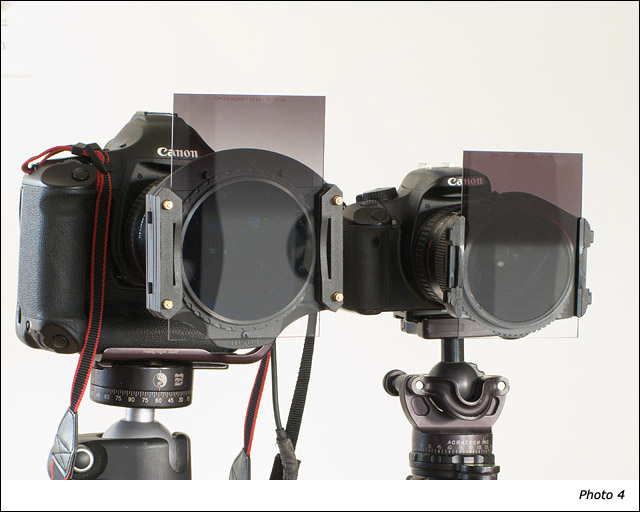
When I backpack, I will often take my 17-40mm or 24-70 mm lens and my full frame camera. Whenever I use these lenses, I always take my Cokin Z-pro holder and my 4x6-inch filters so I do not have to worry about vignetting. I do not hand-hold grads in front of my lens mostly because I like long exposures (4 seconds to 4 minutes) and holding filters that long is problematic. I like using a holder to mount multiple filters and the 4x6-sized holder solves the problems I get when using these wide-angle zooms. For example, Photo 5 was taken using my 24-70mm lens at 24mm on my full frame camera. I used the Cokin P164 polarizer, a Singh-Ray 2 stop hard-edge grad over the sky and lit peak and a 5-stop solid ND filter to lengthen exposure to give me cloud movement and more color build-up. The total exposure time was 118 seconds – I could not hand-hold three filters for that long! The Cokin Z-Pro holder allowed me to stack all three filters with no vignetting to get the final effect I envisioned.
So… what size holder should you buy? That depends… but hopefully this article will give you the information you need to weigh the pros and the cons of your choice. Happy filtering!
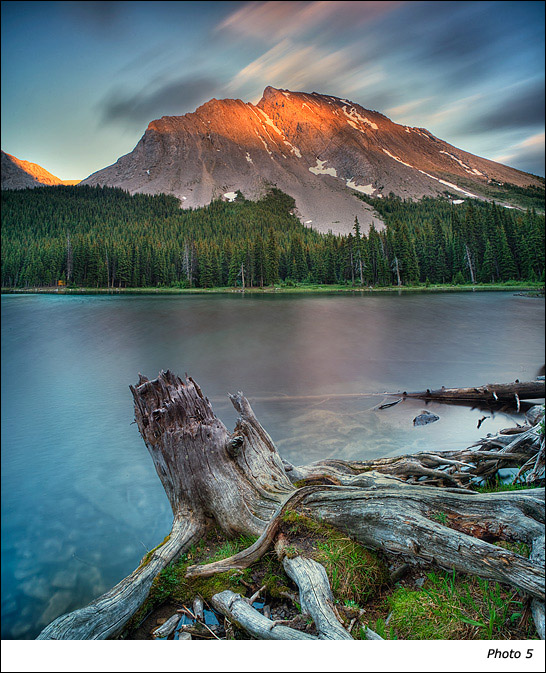
Comments on NPN digital nature photography articles? Send them to the editor.
Darwin Wiggett is a professional nature and outdoor photographer from Alberta, Canada. You can see more of his work at www.darwinwiggett.com or at www.timecatcher.com.